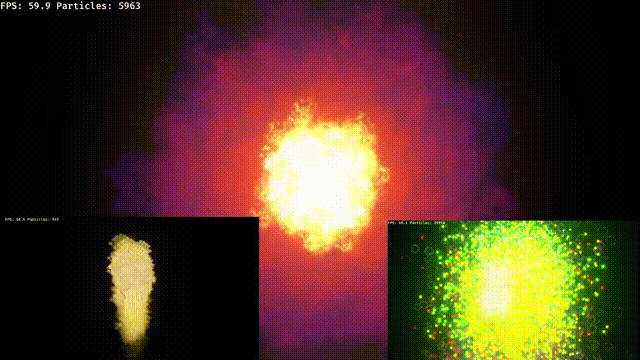8 releases
| 0.3.3 | Dec 8, 2024 |
|---|---|
| 0.3.2 | Dec 5, 2024 |
| 0.3.0 | Nov 30, 2024 |
| 0.2.2 | Jul 18, 2024 |
| 0.1.0 | Mar 30, 2024 |
#133 in Graphics APIs
71 downloads per month
Used in enoki2d_editor
57KB
1.5K
SLoC
Bevy Enoki
Enoki - A 2D particle system for the Bevy game engine.

Overview
The Enoki particle system is a CPU calculate particle system, that uses GPU Instancing and works well in wasm and mobile.
You have access to a Material Trait which let's you implement your own
fragment shaders on top. Resulting in a powerful tool to build any modern VFX effect.
Additionally, spawner configuration are provided via ron files, which can be hot reloaded.
The default material allows not only for custom textures, but also sprite sheet animations over the particle lifetime.
Compatibility
| bevy | bevy_enoki |
|---|---|
| 0.15 | 0.3.3 |
| 0.14 | 0.2.2 |
| 0.13 | 0.1 |
Editor
Enoki has a feature rich Editor.

- load and save effect assets.
- watch a shader file with hot reload, your editor of choice.
- load a texture.
- play with values.
Get started by installing it via cargo
cargo install enoki2d_editor
Examples
cargo run -p example --bin material
cargo run -p example --bin sprites
cargo run -p example --bin dynamic
Usage
Add the bevy_enoki dependency to your Cargo.toml
bevy_enoki = "0.2.2"
Add the EnokiPlugin to your app
App::new()
.add_plugins(DefaultPlugins)
.add_plugins(EnokiPlugin)
.run()
Create your first particle spawner.
use bevy_enoki::prelude::*;
fn setup(
mut cmd : Commands,
mut materials: ResMut<Assets<SpriteParticle2dMaterial>>,
server : Res<AssetServer>,
){
cmd.spawn(Camera2dBundle::default());
// minimal setup
// white quads with a default effect
cmd.spawn(
// the main component.
// holds a material handle.
// defaults to a simple white color quad.
// has required components
ParticleSpawner::default()
)
// bring in your own effect asset from a ron file
// (hot reload by default)
cmd.spawn((
ParticleSpawner::default(),
// the effect components holds the baseline
// effect asset.
ParticleEffectHandle(server.load("firework.particle.ron")),
));
// now with a sprite sheet animation over lifetime
let sprite_material = materials.add(
// the other args (hframes and vframes) defines how the sprite sheet is divided for animating,
// you can also just use `form_texture` for a single sprite
SpriteParticle2dMaterial::new(server.load("particle.png"), 6, 1),
);
cmd.spawn((
ParticleSpawner(sprite_material),
ParticleEffectHandle(server.load("firework.particle.ron")),
));
}
Control your particles
There 4 main components you can play with. These are required by the ParticleSpawner
and thus added, if not provided.
ParticleSpawnerState: Controls the spawner state.ParticleEffectInstance: A unique clone of the effect. Can be changed at runtime, only affects the spawner attached to. Will reload, when the asset changes.ParticleEffectHandle: A link the main effect asset.ParticleStore: Holds the particle data. You mostly won't interact with this.OneShot: A optional Tag component. That will either deactivate or delete the spawner, after first burst is done.NoAutoAabb: Opt out of auto Aabb calculation.
Create a custom Material
Just like any other Bevy material, you can define your own fragment shader.
#[derive(AsBindGroup, Asset, TypePath, Clone, Default)]
pub struct FireParticleMaterial {
#[texture(0)]
#[sampler(1)]
texture: Handle<Image>,
}
impl Particle2dMaterial for FireParticleMaterial {
fn fragment_shader() -> bevy::render::render_resource::ShaderRef {
"custom_material.wgsl".into()
}
}
fn setup(){
App::default()
.add_plugins(DefaultPlugins)
.add_plugins(EnokiPlugin)
.add_plugins(Particle2dMaterialPlugin::<FireParticleMaterial>::default())
.run()
}
Create a shader
//assets/custom_material.wgsl
#import bevy_enoki::particle_vertex_out::{ VertexOutput }
@group(1) @binding(0) var texture: texture_2d<f32>;
@group(1) @binding(1) var texture_sampler: sampler;
@fragment
fn fragment(in: VertexOutput) -> @location(0) vec4<f32> {
var out = in.color
// go wild
return out;
}
That's it, now add the Material to your Spawner! These are the values provided by the vertex shader:
struct VertexOutput {
@builtin(position) clip_position: vec4<f32>,
@location(0) @interpolate(flat) color: vec4<f32>,
@location(1) uv : vec2<f32>,
@location(2) lifetime_frac : f32,
@location(3) lifetime_total : f32,
};
The Effect Asset
#[derive(Deserialize, Default, Clone, Debug)]
pub enum EmissionShape {
#[default]
Point,
Circle(f32),
}
#[derive(Asset, TypePath, Default, Deserialize, Clone, Debug)]
pub struct Particle2dEffect {
pub spawn_rate: f32,
pub spawn_amount: u32,
pub emission_shape: EmissionShape,
pub lifetime: Rval<f32>,
pub linear_speed: Option<Rval<f32>>,
pub linear_acceleration: Option<Rval<f32>>,
pub direction: Option<Rval<Vec2>>,
pub angular_speed: Option<Rval<f32>>,
pub angular_acceleration: Option<Rval<f32>>,
pub scale: Option<Rval<f32>>,
pub color: Option<LinearRgba>,
pub gravity_direction: Option<Rval<Vec2>>,
pub gravity_speed: Option<Rval<f32>>,
pub linear_damp: Option<Rval<f32>>,
pub angular_damp: Option<Rval<f32>>,
pub scale_curve: Option<MultiCurve<f32>>,
pub color_curve: Option<MultiCurve<LinearRgba>>,
}
This how you create a MultiCurve. Currently, Supports LinearRgba and f32.
RVal stands for any Value with a randomness property between 0 - 1.
let curve = MultiCurve::new()
.with_point(LinearRgba::RED, 0.0, None)
.with_point(LinearRgba::BLUE, 1.0, Some(EaseFunction::SineInOut));
// max 1.0, randomness of 0.1 (0.9 - 1.1)
let rval = Rval::new(1.0, 0.1);
Dependencies
~59–97MB
~1.5M SLoC